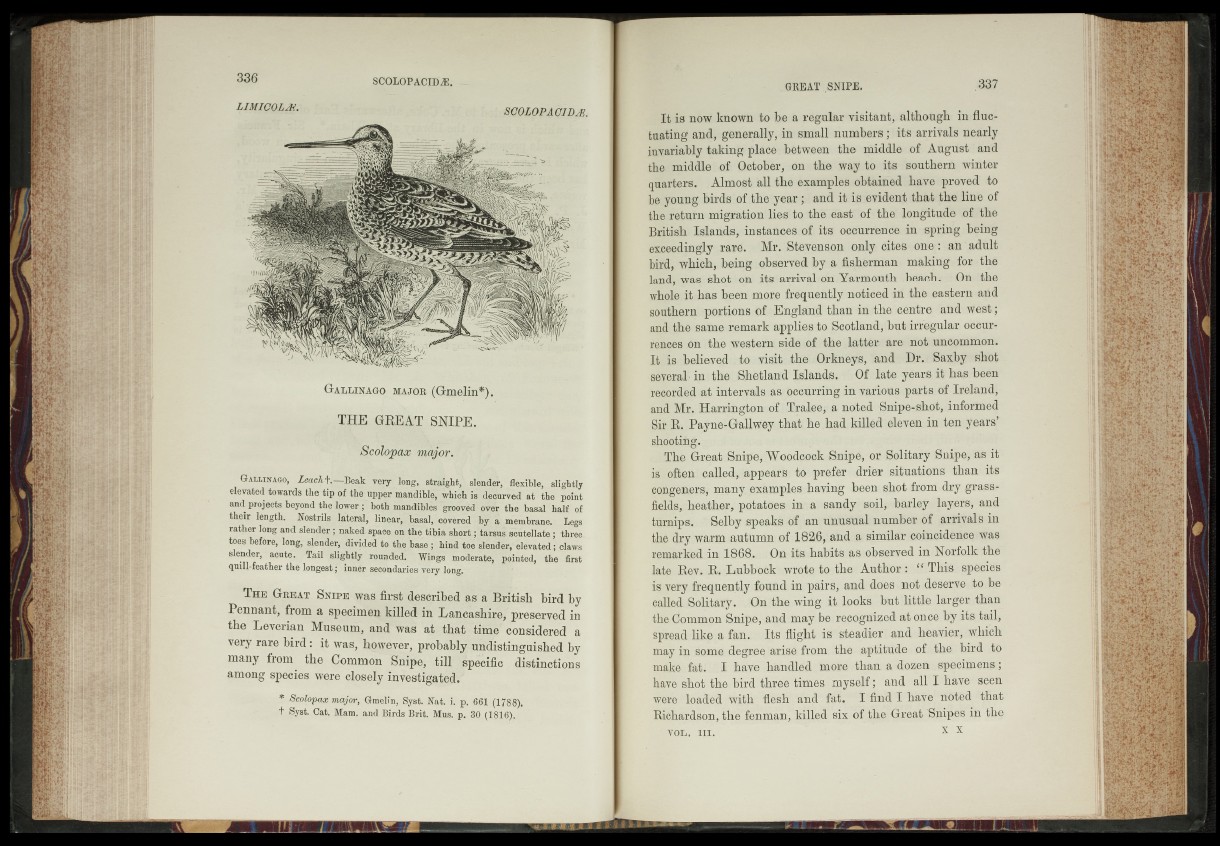
LIMICOLAt. SCOLOPACID^E.
G allinago major (Gmelin*).
| THE GREAT, SNIPE.
^Scolopad Tnajor. -1
Gauotaqo, ZracAf^-Beak very’ lqn^; straight,' slender, ^flexible,. slightly
elevated towards the tip of the-upper mandible,' which' is ^U rv e d at ' the' point
and projects beyond the low e rb o th mWiblSs^grodv&d pvwr the basal half' of
their length. Nostrils lateral, linear^ basal, covered by a membrane. Legs
rather long and slender; naked space on the tibia short; tarsus, scutellate; three
toes before, long, slender'^vjded-to the base ; hind toe' slendw,'elevated ;$lWs
slender, acute. Tail slightly rounded. Wings moderate^ ta in t e d , the first
quill-feather the longest; inner secondaries very long.-
The Great Snipe was first described as a British bird by
Pennant, from a specime^ killed in Lancashire/ preserved in
the Leverian Museum, and was a t that time considered a
very rare bird: it was, hqwqver, probably undistinguished by
many from the ^ om m ^ Snipe, till;/specific distinctions
among species were closely investigate!/
* Scolopax major, Gmelin,.Syst. Nat. (17838).
, t Syst. Cat. Mam. and Birds Brit. Mus. p. 3 ^ (3 81 § ) J
It is now known to be a regular visitant* although in fluctuating
and, generally, in small numbers / # s arrivals nearly
invariably taking place between the middle of August and
the middle of October, on the way to its southern winter
quarters. Almost all the examples obtained have proved to
be young birds-of the year and it. is evident that the linfe of
the return migration lies' to the east1 -of* the' longitude of the
British Islands, instances of its occurrence, in '.spring being
exceedingly rare. Mr. (Steven spn only cites‘.one-: an'adult
bird, which, being observed by a fisherman, making for the
land, was shot on its .arrival-on Yarmouth beach.- On the
whple.jt has been more frequently noticed id the eastern and
southern portions oX-England than in.the centre afad west?
and-the same remark applies ,to Scotland, but irregular occur*
renees on the western sid&#f-the latter, are not uncommon.
J|t is believed |to. visit;the Orkneys, "and Dr.- Saxby shot
several;- in the Shetland Islands, | Of late yearsit has been
recorded at intervals as? Occurring in various parts of Ireland,
and Mr. Harrington off Tralee,-a noted Snipe-shot, informed
Sir R. Payne-GallWey that[,he,had killed .eleven in ten years?
shootihg.
The Great Snipe, iWeod^eeh Sniper ©rSolit ary Snipe,, as it
often: called, appears- t$-,-prefer drier situations than its'
eo&gehers, many, examplesbaying been shot from dny grass?
fields-, heather, potatoes- in; a sandy sojlj barley-j.Iayers, and
turnips,..-/Selby -speaks of an unusual number, of -.arrivals.is
the dry warm autumn of ,18,26, and a similar'Coincidence, was
remarked in. .1 &68.;f its habits aS.'Observed is Norfolk the
latp., Rev. Rv-hhbbock wrote to the - Author;:; “ This sprigs
is-very frequently found in pairs,- and ddes> ,npjt deserve/to be
called Solitary. , Gn‘ the wing it locks but ftiftle. larger- than
the Common Snipe, and maybe.frecoghi^cdsfl; onpe by it$,tail>
spread like a fa.n.,. Its iftgh.k is^lteadie-r| and hCaviejsj'which
may is.Jnme.Aeg35gqLaris^ frQm.ithe aptitude oh the! bird Jig
m.ake fat/- I have handed 'more than a Specimens.;
have shot the bird three times-tjmyself; and- all I have ‘ seen
were with flesh' and ffit.f ’t /;4nd I have/noted^hat
Richardson, the fenman' killed six of the $reat ’Snipe's in the
yoL. in.. ■ x x .